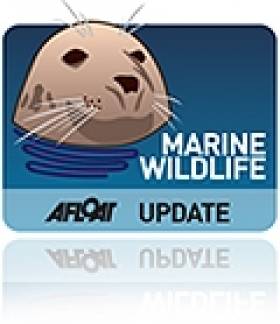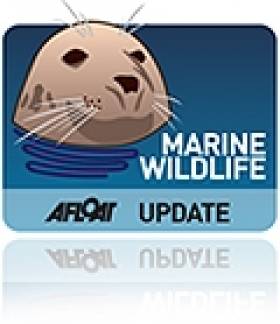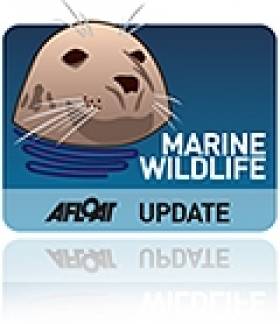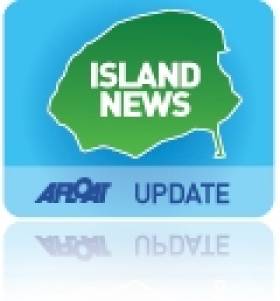Displaying items by tag: Special Areas of Conservation
Government Approval for Two New Special Areas of Conservation off Irish Coast Welcomed by Environmental Network
The Government has approved two new Special Areas of Conservation (SAC) off the Irish coast.
The two areas selected under the EU Habitats Directive extend over a combined area of three million hectares, according to Minister of State for Heritage Malcolm Noonan
Mr Noonan also confirmed Government approval for the general scheme of the Marine Protected Areas Bill, before travelling to the UN Biodiversity Conference, COP15, in Montréal, Canada.
The two SACs are located off the northwest coast and off the south coast.
 Ireland's underwater world by Libby Keatley
Ireland's underwater world by Libby Keatley
Noonan said both were selected “due to the presence of the internationally-protected deep-water reef habitat, a unique ecosystem that supports a wide range of marine species”.
He said work is also well advanced on the selection of a number of internationally important sites for birds – Special Protection Areas - under the EU Birds Directive.
He said the formal notification process is expected to begin in the coming months and will soon bring Ireland’s total marine areas protected under the European Nature Directives over the 10% target.
Efforts are being prioritised along the country’s east coast, in the Irish Sea, while further work is underway on the southern and western coasts, he said.
The developments were welcomed by the Fair Seas network. It said the proposed new legislation will allow Ireland to designate new nationally based marine protected areas (MPAs), helping it meet its national and international commitments, and giving nature at sea the best opportunity to not only survive, but thrive.
“Ireland currently has 2.1% MPA coverage, but with today’s announcement of the new SACs off the north west, and south west coasts of Ireland, that number has increased to 8.3%, “it noted.
“ The creation of two new SACs should be celebrated, this is a significant step in the right direction,”Fair Seas campaign manager Aoife O’Mahony said. H
“owever, considering the global biodiversity crisis we are now facing, it’s essential that proper management plans are put in place for these and all other existing MPAs too.”
The Southern Canyons SAC site is approximately 280 km south of counties Cork and Kerry.
Fair Seas noted that it is “home to diverse reef communities and corals, as well as larger fauna such as long-finned pilot whales and numerous fish species”, including the Whittard Canyon system which has been described as comparable in scale and drama to the Grand Canyon in the USA.
“ Important at-risk species of seabird are frequently present here such as the red-listed kittiwake and puffin,”it said.
“The Porcupine Shelf SAC site extends north from an area due west of Clew Bay, Co Mayo to an area west of Malin Head, Co Donegal. Biologically sensitive reef-forming, cold-water coral species are found in this area. So too are various species of whale, dolphin, shark and ray. A range of breeding birds, including the arctic tern, puffin, storm-petrel and Manx shearwater, are also found in this area,” Fair Seas said.
The new sites overlap with areas highlighted by Fair Seas in its June 2022 report identifying ‘Areas of Interest’ for MPA designation, the network said.
Fair Seas involves environmental non-governmental organisations and networks, including the Irish Wildlife Trust, BirdWatch Ireland, Sustainable Water Network, Irish Whale and Dolphin Group, Coomhola Salmon Trust, Irish Environmental Network and Coastwatch.
Dublin Bay Porpoises Protected Under New Irish SACs
#MarineWildlife - The Irish Whale and Dolphin Group (IWDG) has welcomed the designation of a new special area of conservation (SAC) for marine wildlife in Dublin Bay.
As reported yesterday on Afloat.ie, Heritage Minister Jimmy Deenihan was on board the IWDG's research vessel Celtic Mist in Dun Laoghaire on Tuesday 16 July to lance the group's new atlas of marine mammal distribution in Irish waters - an event at which he also confirmed his extension of the protections already afforded to whales and dolphins over a number of coastal sites around Ireland.
The Dublin Bay SAC, running from Rockabill off Skerries to Dalkey Island, is one of the six new sites proposed by the minister's department late last year.
The list also features Blackwater Bank in Co Wexford, the West Connacht Coast, Hempton's Turbot Bank in Donegal, the Porcupine Bank Canyon off Kerry and the South-East Rockall Bank.
According to The Irish Times, the Dublin Bay conservation zone alone covers a sea area of 27,000 hectares and will extend protections under the 1992 EU Habitats Directive to the area's population of harbour porpoises.
West Cork Weekends Will Bring You Closer To Marine Wildlife
#MarineWildlife - If you've ever wanted to get closer to Ireland's marine wildlife, a new series of weekend excursions in West Cork may be just the ticket.
The Southern Star reports on the 'Discover Wildlife Weekends' being run from Rosscarbery by local company Ireland's Wildlife starting this April, where those taking part will be led by expert guides to explore the coastal region and have the best opportunities to spot the many species of whales and dolphins that visit our shores.
Weather permitting, the weekends will also involve some offshore whale watching in the company of 'whale watch supremo' Colin Barnes and the Irish Whale and Dolphin Group's (IWDG) sightings co-ordinator Pádraig Whooley.
And birdwatching will also be a feature, as West Cork is a hotspot for our feathered friends - from merlins and peregrine falcons to coastal waders and more exotic fowl that skirt our coasts on their spring migrations.
The Southern Star has much more on the story HERE.
Meanwhile, marine sector stakeholders have expressed their concerns over the designation of six new offshore marine areas by the National Parks and Wildlife Service.
As previously reported on Afloat.ie, the six sites at Blackwater Bank in Wexford, the West Connacht coast, Hempton's Turbot Bank in Donegal, the Porcupine Bank Canyon off Kerry, the South-East Rockall Bank, and the stretch from Rockabill to Dalkey Island off Dublin have been proposed for designation as Special Areas of Conservation (SACs) to protect marine habitats and species listed on the 1992 EU Habitats Directive.
But at a recent meeting at the Irish Farm Centre in Dublin, a coalition of fish farmers, fishermen and marine energy stakeholders have hit out at what they characterise as "the appalling handling of inshore designations since the 1990s by the State", which they claim "has resulted in hundreds of job losses and a flight of serious investment" from Ireland's coastal areas.
“Our experience of the Irish Government’s application of the EU Habitats Directive has been a saga of mismanagement, foot dragging and buck-passing which has left over 500 fish farming licences in limbo for over 10 years and a backlog of red tape and bureaucracy which could see producers waiting until 2020 and beyond for simple renewals which are vital to underpin their businesses," said IFA aquaculture executive Richie Flynn.
"These new offshore SACs will have the same effect of preventing any fishing, marine energy or aquaculture being carried out in these areas if left in the hands of the same agencies to manage."
Six New Marine Sites Chosen for Conservation
#MarineWildlife - Minister for Arts, Heritage and the Gaeltacht Jimmy Deenihan announced on Wednesday the proposal of six new marine sites for designation as Special Areas of Conservation (SACs) to protect marine habitats and species listed on the 1992 EU Habitats Directive.
The six sites around the Irish coast represent habitats (sandbanks and reefs) and/or marine wildlife (specifically dolphins and porpoises) identified as insufficiently represented in the list of Irish SACs at the EU Commission's Marine Atlantic Biogeographic Seminar in 2009. These sites are:
- Blackwater Bank, Co Wexford (Sandbank)
- West Connacht Coast (Bottlenose dolphin)
- Hempton’s Turbot Bank, Co Donegal (Sandbank)
- Rockabill to Dalkey Island, Co Dublin (Reefs and harbour porpoise)
- Porcupine Bank Canyon, off Kerry (Reefs)
- South-East Rockall Bank (Reefs)
The designation of marine SACs is scheduled for completion in Europe in 2012, and according to the minister, this list of six additional SACs will constitute Ireland’s contribution to that process.
In a statement, the department said: "These six SAC sites will protect a range of habitats and species including sandbanks, deep sea coral reefs, dolphins off the Atlantic coast and harbour porpoises found in Dublin Bay.
"These sites are part of a European network of nature conservation sites known as Natura 2000 which was established with the aim of preserving our rich natural heritage for future generations."
Among the new designations are two offshore sites at the Porcupine Bank Canyon and the South East Rockall Bank "contain excellent examples of offshore fauna associated with geogenic reef (ie reef made of rock). Considering the extent of Ireland’s offshore maritime area alongside the value and vulnerability of deep sea biodiversity therein, these two sites represent a modest but highly significant contribution to the Irish SAC network."
Two new inshore areas are being proposed in the west of Ireland to protect the bottlenose dolphin. The department is currently co-funding a multi-annual research programme to further understand the ecology of this species in this coastal region.
Meanwhile, the inshore site off Dublin from Rockabill to Dalkey Island is also being proposed both for the harbour porpoise, and for geogenic reef to address a gap in the SAC network for this habitat type in the northern part of the Irish Sea.
As previously reported on Afloat.ie, the oil exploration company behind the Dalkey Island Prospect has spoken out over the Rockabill to Dalkey Island designation, claiming it had not been given advance information of the decision.
Providence Resources says maps provided by the department appear to show and overlap between the location for a seismic survey and the new SAC area, which would make any development for resource extraction "extremely problematic".
Last week the Irish Whale and Dolphin Group (IWDG) expressed concern over the potential impact of the 2D seismic survey at Dalkey Island on harbour porpoises in Dublin Bay.
Prices Drop On Private Islands
It's never been easier to own your own private island, with some going for less than €200,000, according to The Irish Times.
Cork-based estate agent Dominic Daly currently has islands on his books in west Cork, Donegal and the Shannon Estuary. But he warns that islands can be difficult to sell, as planning permission for residences is often hard to obtain.
Another agent, Philip O'Reilly in Ennis, says some islands are designated as Special Areas of Conservation, which means even building a landing jetty is out of the question. But on the plus side, owners are now much more open to lower offers.
The Irish Times has more on the story, including details of a number of islands on the market, HERE.



























































